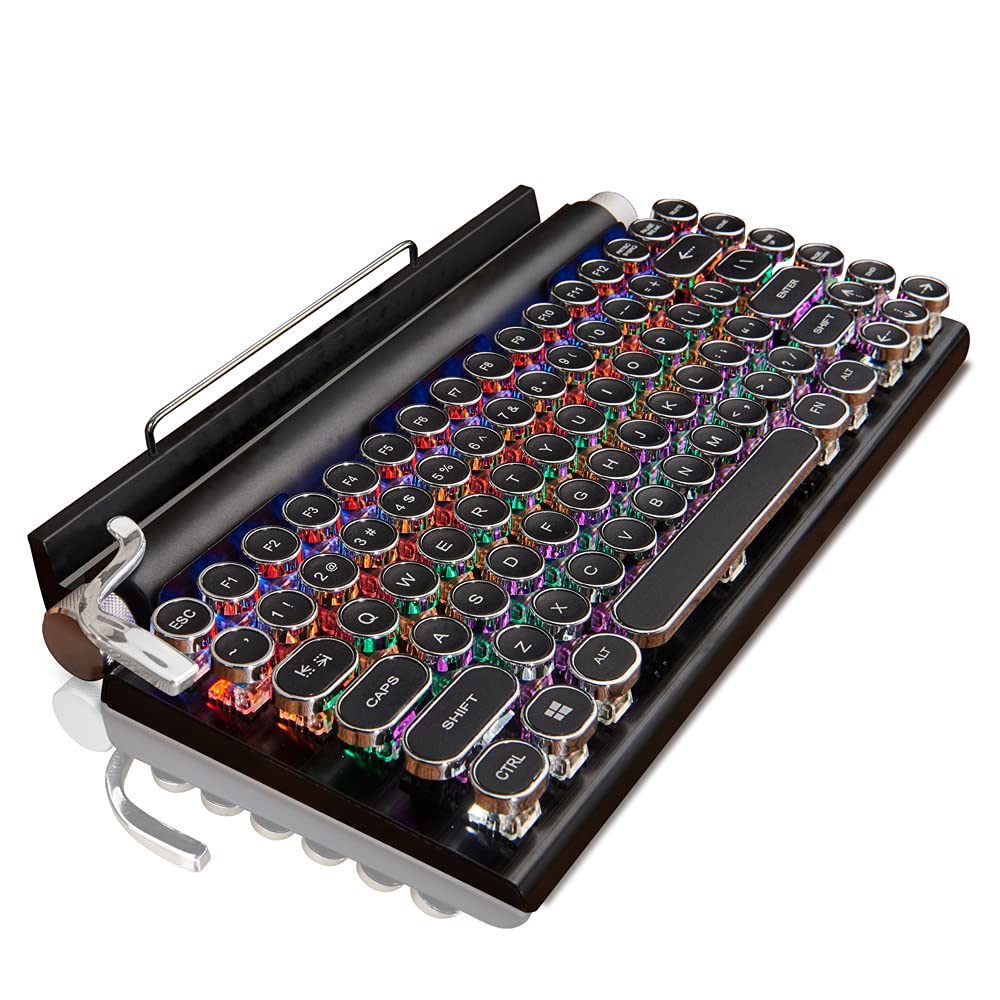Typewriter Keyboard: A typewriter is a mechanical or electromechanical device used for writing text onto paper by pressing keys that cause inked letters or symbols to be printed. It was widely used before the advent of modern computers and printers.
Key Characteristics:
- Manual Operation:
- Early typewriters required manual force to press the keys, which struck a ribbon of ink against paper.
- Keyboard Layout:
- Typically features a QWERTY keyboard layout, though alternative layouts existed.
- Carriage:
- A moving part that holds the paper and advances it after each keypress or at the end of a line (with the use of a return lever).
- Ribbon and Ink:
- A spool of inked ribbon is struck by typebars or a type wheel to create impressions on the paper.
- Non-Digital:
- Unlike modern keyboards, typewriters do not have digital or electronic capabilities.
Historical Context:
- The first practical typewriter was invented in 1868 by Christopher Latham Sholes and later marketed as the Sholes and Glidden Type Writer in 1874.
- Typewriters revolutionized writing and documentation by allowing faster, more legible, and standardized text creation compared to handwriting.(laptop keyboard not working)
Modern Usage:
While largely replaced by computers and word processors, typewriters are still valued for their nostalgic appeal, durability, and simplicity in specific applications like art, journaling, or use in areas without electricity.
If you’re looking for a typewriter-style keyboard for your computer, there are several options available that combine retro aesthetics with modern functionality. These keyboards are designed to look like vintage typewriters but work seamlessly with modern computers via USB or Bluetooth. Here are a few popular choices:
1. Qwerkywriter
- Features:
- Mechanical switches for a tactile typing experience.
- Integrated tablet stand.
- Multi-device Bluetooth connectivity.
- Metal construction for a premium feel.
- Best for: Those who want the most authentic typewriter feel with high-end features.
- Price: Premium.
2. Azio Retro Classic
- Features:
- Genuine leather or wood surface options.
- Mechanical switches with LED backlighting.
- USB and Bluetooth options.
- Adjustable height with retro-style feet.
- Best for: Style enthusiasts who value customization and quality materials.
- Price: Mid to high range.
3. Rymek Retro Keyboard
- Features:
- Vintage design with mechanical switches.
- Dual Bluetooth and wired connectivity.
- LED lighting with customizable colors.
- Compatible with smartphones, tablets, and computers.
- Best for: Multi-device users who love flashy lighting.
- Price: Mid-range.
4. Lofree Keyboards
- Features:
- Compact, colorful, and stylish retro designs.
- Mechanical switches.
- Wireless and USB options.
- Backlighting for enhanced visibility.
- Best for: Users who prefer compact keyboards with playful designs.
- Price: Affordable to mid-range.
Things to Consider:
- Switch Type: Choose mechanical switches (e.g., Cherry MX or equivalent) for a more authentic tactile feel.
- Connectivity: Decide between wired, Bluetooth, or dual-mode options.
- Compatibility: Ensure the keyboard is compatible with your device (Windows, macOS, or Linux).
- Aesthetics vs. Functionality: Some typewriter-style keyboards prioritize design over ergonomic or functional aspects.(Razer Keyboard)
Typewriter keyboard Layout
The layout of a typewriter keyboard closely resembles the modern QWERTY keyboard layout, as the latter was directly derived from typewriter designs. However, there are some subtle differences, particularly in the placement of certain keys and symbols. Here’s a breakdown:
Key Features of a Typewriter Keyboard Layout
- QWERTY Arrangement:
- The typewriter keyboard uses the same QWERTY key arrangement for letters as modern keyboards.
- No Function Keys:
- Traditional typewriters do not have function keys (F1–F12), ESC, or other modern additions like Home, End, or Delete.
- Caps Lock vs. Shift Lock:
- Early typewriters used a Shift Lock key instead of a Caps Lock.
- This locked the typewriter into a “Shifted” state for uppercase letters and special characters.
- No Numeric Keypad:
- Typewriters didn’t include a dedicated numeric keypad. Numbers were typed using the top row of keys.
- Limited Symbols:
- Fewer symbols were available compared to modern keyboards. For example:
- The number “1” was often substituted with a lowercase “l” (L).
- Some typewriters lacked a dedicated exclamation mark (!) and required typing a period (.) followed by backspacing and typing an apostrophe (‘).
- Enter/Return Key:
- The Return lever on typewriters performed the equivalent of today’s Enter key and also moved the carriage to the next line.
- Backspace:
- Typewriters had a Backspace key, but it did not erase text. It simply moved the carriage back one space.
- Tab and Margin Keys:
- Tabs were used to align text quickly, and typewriters often had physical margin settings controlled by levers or buttons.
- Special Characters:
- Characters like “@” and “#” became more common in later typewriters but were not always included in older models.
Modern Adaptations in Typewriter-Style Keyboards
Typewriter-style keyboards for computers maintain the classic QWERTY layout but include additional keys like function keys, multimedia controls, and the numeric keypad for modern use. They also emulate the tactile, clicky feel of mechanical typewriter keys.

